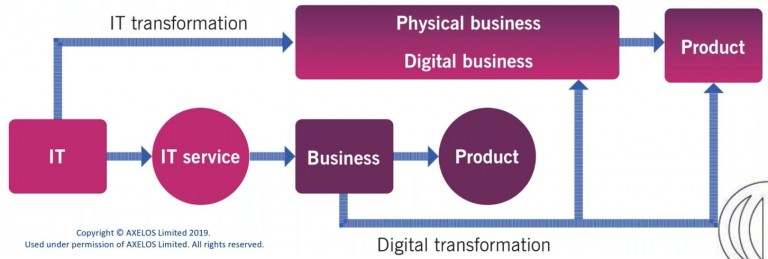The transition from ITIL v3 to ITIL 4 has led to changes in the focus of ITIL itself: if the old version was aimed mainly at organisations and/or IT departments, the ITIL 4 has the focus on the entire organisation with particular attention to digital service management.
In practice this means that in the past IT was the driving force of business as usual, while nowadays IT drives towards new business through digital innovation. IT has a solid place in the broader perspective of a digital organisation.
The definition of a Digital Organisation
A digital organisation is an organisation that, thanks to the rise of digital technology, can perform in an innovative digital environment and on a larger-scale.
For a digital organisation, digital technology is vital. It is not a mere question of dematerialization, as the transition from paper invoice to electronic could be, but it is a question related to business models as digitalization allows the organisation to provide products and/or services that previously were not feasible.
Digital technology drives evolution rather than the business itself. Digital organisations must apply digital technology, they must do it quickly and they need to accelerate in terms of time to market and be ready for sudden changes.
ITIL wants to support digital organisations in the application of digital technology in being able to respond to business needs according to fundamental variables such as time-to-market, time to change and speed.
ITIL High Velocity IT (HVIT)
The concept and need for high velocity can change depending on the organisation. Some organisations are more digital than others and some have a higher need for high velocity IT. However this does not mean that the whole organisation has to go at high speed.
For example, one solution might be to apply High Velocity IT to customer-oriented and front office systems, but keep a traditional back office approach.
So, not only do not all organisations necessarily have to apply HVIT, but not all departments of an organisation need to go at the same speed either.
How should an organisation deal with digital transformation?
Digital transformation and IT transformation are two very different concepts. Business services, in fact, must be divided from the purely IT aspects. An organisation can go through a digital transformation and change practices completely.
Often, in organisations where business and IT are very separate and have few interactions, transformation is only applied to the IT department. In this case we are talking about IT transformation and not digital transformation because, when it comes to only updating internal IT services, the transformation will have little impact on customer interaction:

In digital organizations, on the other hand, IT drives business units to pursue new markets or develop new products or services. Compared to traditional products, these organisations offer digital products and services and transforming these is called digital transformation.
Digital Product Lifecycle
We speak of a digital product when digital technology plays a prominent role among the resources that make up the product and the interaction services associated with it.
Digital services are based on one or more digital products that can substantially change a user’s experience, such as online banking, digital booking of airline tickets, streaming services, etc ….
In this context, the logic in terms of the life cycle of a digital product also changes, both from the perspective of the customer (service consumer) and from the perspective of the service provider.
Two perspectives; the service consumer and the service provider
From the service consumer perspective, the life cycle begins when the customer seeks the solution to a possible need. For the customer, the need matures the idea of a possible product.
From the perspective of the service provider, however, the life cycle begins with market research activities to find investment opportunities for new customers and potential customers for existing products.
When from the perspective of a customer a certain product or service will no longer be satisfactory, this does not imply that the same product or service cannot still be interesting for other customers: from the perspective of a service provider, the life cycle of a product or service can then go beyond the single customer perspective.
If you want to have a complete view of the ITIL 4 Specialist High Velocity IT module, you can watch our webinar with the expert Kais Albassir. Follow the link to see the free registration!
The ITIL 4 Specialist High Velocity IT module focuses on organisations that work in dynamic and agile contexts. These organisations demonstrate how the ITIL operating model, principles and practices can be used digitally, from optimisation to radical transformation. For all information, consult the scheduled courses or write to us!









